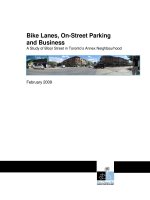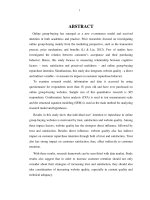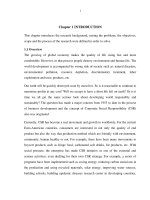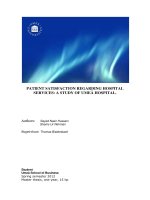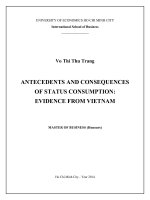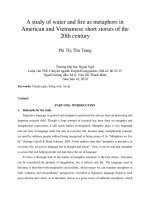Tourist satisfaction antecedents and consequences a study of package tours at ninh thuan
Bạn đang xem bản rút gọn của tài liệu. Xem và tải ngay bản đầy đủ của tài liệu tại đây (1.52 MB, 85 trang )
TOURIST SATISFACTION: ANTECEDENTS AND CONSEQUENCES
A STUDY OF PACKAGE TOURS AT NINHTHUAN
In Partial Fulfillment of the Requirements of the Degree of
MASTER OF BUSINESS ADMINISTRATION
In Marketing major
By
Ms. Le Chi Nga
Advisor: Assoc. Prof. Le Nguyen Hau
ID MBA03022
International University - Vietnam National University HCMC
August 2014
-ii-
TOURIST SATISFACTION: ANTECEDENTS AND CONSEQUENCES
A CASE STUDY OF PACKAGE TOURS AT NINHTHUAN
In Partial Fulfillment of the Requirements of the Degree of
MASTER OF BUSINESS ADMINISTRATION
In Marketing major
by
Le Chi Nga
ID: MBA 03022
International University - Vietnam National University HCMC
August 2014
Under the guidance and approval of the committee, and approved by all its members, this
thesis has been accepted in partial fulfillment of the requirements for the degree.
APPROVED BY: COMMITTEE,
________________________
_______________________________
______________________________
_______________________________
_______________________________
-iii-
-iv-
ACKNOWLEDGEMENT
To complete this thesis, first and foremost, I would like to express my deep and
sincere gratitude to my advisor, Assoc. Prof. Le Nguyen Hau for his enthusiasm, dedication,
support and guidance throughout my thesis. I really appreciate the invaluable advice that he
has given to me.
My greatest thanks go to my dear parents for always by my side and encouraging me.
They have given me unconditional love and support throughout my life. To my mom and
dad, I love you and hope I could make you proud.
Last but not least, I wish to give a special thank to my friends and other people who
helped and supported me during conducting this thesis.
-v-
Plagiarism Statements
I would like to declare that, apart from the acknowledged references, this thesis either
does not use language, ideas, or other original material from anyone; or has not been
previously submitted to any other educational and research programs or institutions. I fully
understand that any writings in this thesis contradicted to the above statement will
automatically lead to the rejection from the MBA program at the International University –
Vietnam National University Hochiminh City.
-vi-
Copyright Statement
This copy of the thesis has been supplied on condition that anyone who consults it is
understood to recognize that its copyright rests with its author and that no quotation from the
thesis and no information derived from it may be published without the author’s prior
consent.
© Le Chi Nga/ MBA03022/2014
-vii-
Table of Contents
ACKNOWLEDGEMENT ....................................................................................................... v
Copyright Statement ..............................................................................................................vii
Chapter I - Introduction .................................................................................................... 13
1. Introduction .................................................................................................................... 13
2. Objectives........................................................................................................................ 15
3. Practical significance ..................................................................................................... 15
4. Scope of the research ..................................................................................................... 15
Chapter II – Literature review and research model....................................................... 17
2.1. Literature review ........................................................................................................ 17
2.1.1. Tuorism industry ................................................................................................. 17
2.1.2. Tourist satisfaction to package tours and its antecedents ................................ 19
2.1.3. Customer loyalty .................................................................................................. 26
2.1.4. Customer satisfaction and relationship with customer’s decision to return/
loyalty .............................................................................................................................. 26
2.1.5. The indepth interviews ........................................................................................ 27
2.2. Research model ........................................................................................................... 29
2.3. Research hypotheses .................................................................................................... 30
2.4. Summary ...................................................................................................................... 30
3.1. Introduction ................................................................................................................. 31
3.2. The process of the reseach .......................................................................................... 31
3.3. Research design ........................................................................................................... 33
3.3.1. Sample ................................................................................................................... 33
3.3.2. Measurement scale .............................................................................................. 33
3.3.3. Questionnaire ....................................................................................................... 34
3.4. Pilot testing .................................................................................................................. 36
3.5. Data collection ............................................................................................................. 36
3.5.1. Data sources .......................................................................................................... 36
3.5.2. Data collection methods ....................................................................................... 37
3.6. Data analysis ................................................................................................................ 38
Chapter 4 – Research Results ............................................................................................... 41
4.1. Introduction ................................................................................................................. 41
4.2. Tourists’ demographics and travel patterns ............................................................ 41
-viii-
4.3. Descriptive statistics.................................................................................................... 44
4. 3. Reliability test ............................................................................................................. 50
4.5. Hypothesis testing ....................................................................................................... 62
4.6. Results of Hypotheses testing ..................................................................................... 67
Chapter V – Conclusions and Recommendations ............................................................... 69
5.1. Conclussion .................................................................................................................. 69
5.2. Recommendations ....................................................................................................... 71
5.3. Limitations and direction for the future research ................................................... 73
APPENDIX A ......................................................................................................................... 76
VIETNAMESE VERSION ..................................................................................................... 76
Phần 1: Thông tin chung ....................................................................................................... 76
ENGLISH VERSION ............................................................................................................. 80
-ix-
Table of Figure
Figure 2.1: Research model .................................................................................................... 29
Figure 3.1 : The reseach process .............................................................................................. 32
-x-
Table of Tables
Table 3.1: Measurement scale ............................................................................... 33
Table 4.1: Tourists’ characteristics ...................................................................... 42
Table 4.2: Tourists’ travel patterns ...................................................................... 44
Table 4.3: Descriptive Statistics of Accommodation .......................................... 45
Table 4.4: Descriptive Statistics of Restaurant ................................................... 46
Table 4.5: Descriptive Statistics of Transportation ............................................ 46
Table 4.6: Descriptive Statistics of Local people ................................................. 47
Table 4.7: Descriptive Statistics of Optional tour ............................................... 47
Table 4.8: Descriptive Statistics of Shopping activities ...................................... 48
Table 4.9: Descriptive Statistics of Tour leader .................................................. 48
Table 4.10: Descriptive Statistics of Overall satisfaction ................................... 49
Table 4.11: Descriptive Statistics of Tourists’ loyalty ........................................ 49
Table 4.12: Reliability test of Acommodation .................................................... 50
Table 4.13: Reliability test of Restaurant ........................................................... 51
Table 4.14: Reliability test of Local people......................................................... 52
Table 4.15: Reliability test of Shopping activities .............................................. 53
Table 4.16: Reliability re - test of Shopping activities ....................................... 53
Table 4.17: Reliability test of Option Tour......................................................... 54
Table 4.19: Re-test for Transportation reliability ............................................. 56
Table 4.20: Reliability test of Tourists’ satisfaction .......................................... 57
Table 4.21: Reliability test of Tourists’ Loyalty................................................. 58
Table 4.22: Re-test for Tourists’ Loyalty............................................................. 58
Table 4. 23: KMO and Bartlett's Test.................................................................. 59
Table4.24: KMO and Bartlett's Test.................................................................... 60
Table 4.25: Rename factors................................................................................... 61
Table 4. 26: Correlationsa ..................................................................................... 63
Table 4.27: Model Summaryb ............................................................................... 64
Table 4.28: ANOVAb ............................................................................................. 64
Table 4.29: Coefficientsa ........................................................................................ 65
Table 4.30: Model Summaryb ............................................................................... 66
Table 4.31: ANOVAb ............................................................................................. 66
Table 4.32: Coefficientsa for HL and TT ............................................................. 67
Table 4.33: Results of Hypotheses testing ............................................................ 68
-xi-
Abstract
Tourists’satisfaction is the most important thing in tourism industry, and Package
tours are the most choosen type for traveling of tourists in Vietnam. This research identify
factors influencing tourist satisfaction to package tour services at NinhThuan destination and
investigate the impact of tourist satisfaction to NinhThuan package tour on intention to
return. The research proposed a model includes factors of package tours such as: Quality of
Acommodation, transportation, restaurant, shopping activities, optional tours, local people,
and tourists’ satisfaction, tourists’ loyalty. The main results indicate that Quality of
Acommodation, transportation, shopping activities, local people, have a posity effect on
tourist’ satisfaction. Factors as Quality of Optional tour, and Quality of restaurant service are
not get the supporting from the test result in having possitive effect on tourists’satisfaction.
For the factor of Professionalism of tour leader, the relationship between this factor and
tourists’satisfaction is not clear. Tourists’ satisfaction has a strong relationship with tourists’
loyalty.
-xii-
Chapter I - Introduction
The goal of the introduction part is to give the reader a short introduction to the topic.
In this section the goals and the structure of the research are introduced. Also, there is a short
description of the case of NinhThuan tourism.
1. Introduction
Tourism is the largest industry on earth. Many countries see tourism as an important
source of new income and foreign exchange, a way to create incentives for local populations
to conserve their environment and cultural heritage, and a means to include new
socioeconomic groups in the benefits of economic growth (J. Edward Taylor, 2010).
Particularly, developing tourist industry is desirable for all countries because it will benefit
not only the industry itself, but also generate a strong flow-through effect in other sectors
such as retail, transportation, and construction (Hui et al., 2007). In tourism activities, the
provision of package tour programs is one of important activities for destination marketing.
According to a report of Vietnam National Administration of Tourism in 2011, in Vietnam,
there were 60% tourists chose package tours for their tours.
Customer satisfaction is the most important thing in tourism industry. Today
competition between travel companies is growing all the time and that is why good service
and customer satisfaction are becoming more and more important. Customer satisfaction has
a positive effect on an organization’s profitability. The more customers are satisfied with
products or services offered, the more are chances for any successful business as customer
satisfaction leads to repeat purchase, brand loyalty, and positive word of mouth marketing. In
the recent decade, decision makers in the tourist industry have been trying to increase the
level of tourist satisfaction in different manners. Consequently, the tourist satisfaction is
viewed as an important research topic by both practitioners and academics (Xia et al., 2009).
-13-
Customer satisfaction leads to repeat purchases, loyalty and to customer retention (Zairi,
2000).
Given the importance of customer satisfaction in the tourist industry, the concern of
tourist marketers is to identify the determinants of tourist’s satisfaction. This is the focus of
this study
About Ninh Thuan tourism,
Ninh Thuan, located in the southern part of Vietnam Central Coastal region, borders
Khanh Hoa in the north, Binh Thuan in the south, Lam Dong in the west, East sea in the East.
Ninh Thuan is a picture of the harmony between the plains, mountains and sea, located
in the national tourism clusters of the triangle Da Lat - Nha Trang - Phan Rang. Ninh Thuan
has Nui Chua National Park and many beautiful landscapes such as Ninh Chu beach, Cà Ná
beach, Ngoạn Mục – spectacular - mountain pass, Đa Nhim hydropower and precious
historical relics are the Cham towers: Poklong Garai, Porome, Hoa Lai, ... are mostly intact.
Vinh Hy Bay, one of the four most beautiful bays in Vietnam, by clear blue water, rocky
mountain and the gorgeous coral reefs. Along with the Chapher falls- one of the highest
warterfall in VN, and the Nại swamp,etc…Ninh Thuận completely qualified to become an
attractive destination in the region and on the national scale.
The huge tourism potential along with the package tour services to Ninh Thuan of
travel agencies has launched in several years, but the results have not been as expected. As a
report of NinhThuan department of cultural, sport and tourism show that tunover from
tourism of NinhThuan in 2011 stay at only 330 billion VND, equivalent to 2,85% of the
GDP. This is a very small number in relation with its potentials. The number of tourists has
returned to Ninhthuan is also very small. Consider with the figure of KhanhHoa - a province
has the same conditions with NinhThuan, in 2005, the tunover from tourism was 643,738
-14-
billion VND equivalent to 40.95% GDP. This showed a very long distance between the two
provinces have same conditions.
This situation gave managers the following questions: whether tourism programs and
the package tour programs to Ninh Thuan have satisfied the customers or not? What factors
that custommers expect from tour programs in general and tour programs to NinhThuan in
particular? What are factors that effect tourist satisfaction to Ninhthuan package tour (NPT)
services?
2. Objectives
Based on the above situation, this study is to:
-
To identify factors influencing tourist satisfaction to package tour services at
NinhThuan destination.
-
To investigate the impact of tourist satisfaction to NinhThuan package tour on
intention to return.
-
To draw managerial implications for maketers.
3. Practical significance
The results and findings will provide extra information concerning customers’ needs,
wants and their satisfaction to domestic package tours and Ninhthuan packake tours. Based
on that, travel agencies could have programs and strategies appropriate to their customers.
4. Scope of the research
The primary data will be collected via about 300 questionare sets from respondents
that live and work in HCMC or tourists are on their tours at NinhThuan who used domestic
package tour service and used Ninhthuan package tour service at least one time.
The secondary data will be collected from 2008-2013.
The research will be conducted from January 2014 to August 2014.
-15-
5. The structure of the research
The research is divided into five sections as follow:
-
Chapter 1- Introduction: give the overview about Problem statement, objectives,
scope, Practical meaning of the research.
-
Chapter 2- Literature review: present theories relative to the study.
-
Chapter 3- Research Methodology
-
Chapter 4- Present analyzing collected data, the resuls.
-
Chapter 5- Conclusions and recommendations.
-16-
Chapter II – Literature review and research model
This section will present theories about tuorism industry in general, package tours,
tourist satisfaction. Previous studies of determinants of tourist satisfaction and intention to
return specifically or loyalty in general are also reviewed. The Model will be showed.
First, this chapter presents difinitions of tourism industry and package tour, why
package tours were chosen the most by tourists.
Second, previous studies about tourist satisfaction will be showed in this chapter.
The last part in this chapter aim to build the research model which be presented base
on the previous theories.
2.1. Literature review
2.1.1. Tuorism industry
2.1.1.1. Tourism
Tourism is traveling to and staying in places outside their usual environment for not
more than one consecutive year for leisure, business and other purposes (World Tourism
Organization. 1995. p. 10. Retrieved 26 March 2009).
Tourism is travel for recreational, leisure, or business purposes. Tourism is an activity
essential to the life of nations because of its direct effects on the social, cultural, educational,
and economic sectors of national societies and on their international relations.
2.1.1.2. Tourist
A person who is supposed to leave his/her hometown (permanent placae) on
temproray, basis fort he purpose of seaking new experiences, having fun & entertaining,
doing sports, seeing cultural & historical places (attractives) etc. On the condition that she/he
should stay no less than 1 day and no longer than 12 months, make use of a tourist facility for
accomodation and spend her/his own Money trough their holiday.
-17-
Tourist means a person who travels for either tourism or for other purposes combined
with tourism, except for those who go to study, work or practice their professions to get paid
at the places of destination. (Vietnam law on tourism, 2005).
2.1.1.3. Tourism activity
Tourism activity means activities of tourists, organizations and individuals doing
tourism business, local communities, agencies, organizations and individuals engaged in
tourism-related activities (Vietnam law on tourism 2005).
2.1.1.4. Toursim business lines
Toursim business is supply tourism services as transportation, accommodation,
entertainment, leisure, and other services aim to meet tourists’needs in a tour.
Tourism business is a trade in services, including the following lines:
Travel business; Tourist accommodation business; Tourist transportation business; Business
in development of tourist resorts or tourist spots; and, Business in other tourist services
(Vietnam law on tourism, 2005).
2.1.1.5. Package tour
Package tour: a combination of several travel components provided by different
suppliers, which are sold to the consumer as a single product at a single price.
A planned tour in which one fee is charged for all expenses. A complete trip, usually
including fare, accommodation, meals, ground transport, tour guides, taxes, etc., in one all
inclusive price.
According to page ACS.edu, Package tours can be further broken down into specific
tour types. Tours available range from Special-interest tours, Adventure tours, City or
Regional tours, Group tours and Fully Escorted tours.
Classification of package tour is based on:
-18-
-
purpose of the journey: honeymoon tours, eco- tour, tours for shopping, culture
tours, etc.
-
price of package tour: cheap tour, high-class tour, ect.
-
duration of tour: weekend tour, short-day tour, multi-day tour, ect.
2.1.1.5.1. Package tour’ advantages which help it become the most (kind of tour)
chosen by tourists
To ACS.edu, when choose a package tour, this will help tourists in cost saving and
budgeting - the price of a trip when organised as a package is generally less as travel agencies
bulk buy their package deals and therefore can sell the tours at a lower and more competitive
rate. Also, as the tour often includes all meals or trips for example, this reduces any
uncertainty about the additional costs and allows the consumer to budget properly for costs
associated with their travel.
Buying a package tour means that if something goes wrong, someone else is there to
solve the problem.
Using a package tour is the most convenient way to arranging a vacation or tour. The
travel agency deals with all the arrangements relating to airlines, hotels, transfers directly
through the tour provider. This saves the consumer the effort and the time of contacting each
company/service individually.
2.1.1.6. Tourist accommodation means an establishment which rents rooms and beds
and provides other related services for guests, of which hotels constitute a major form. (VN
law on tourism.)
2.1.2. Tourist satisfaction to package tours and its antecedents
2.1.2.1. Tourist satisfaction
“Satisfaction is an overall customer attitude towards a service provider, or an
emotional reaction to the difference between what customers anticipate and what they
-19-
receive, regarding the fulfillment of some needs, goals or desire” (Hansemark and Albinson,
2004) .
According to Danaher & Haddrell (1996) and Som & Badarneh ( 2011) Satisfaction
also has been a central subject of tourist’s behaviour. Measuring satisfaction in postconsumption moments aims at providing feedback from a current customer to push
managers towards service improvement.
Many studies about tourist satisfaction recognized that satisfaction have positive
effect on destination selection decisions. And, how important tourist satisfaction to loyalty,
we can find that in An Examination of the Effects of Motivation and Satisfaction on
Destination Loyalty: A Structural Model of Yoon and Uysal (2005), Dimensions of Tourist
Satisfaction with a Destination Area of Pizam, Neumann and Reichel (1978), Tourist
satisfaction: A view from a mixed international guided package tour of Bowie & Chang
(2005), Senior Tourists’ Purchasing Decisions in Group Package Tour (Wang, 2007).
2.1.2.2. Antecedents of tourist satisfaction to package tour
Tourist satisfaction (Kozak & Rimmington, 2000) is an important facet influencing
directly to a success of the destination marketing because it impacts the choice of destination,
the consumption of goods and services, and the decision to return.
In general, tourist satisfaction is based on many factors such as tourist expectations,
destination immage, perceived quality and perceived value. It is also closely related with the
tourists’ post- purchase behavior (tourist’complain and loyalty) (Xiah, 2009).
According to Pizam, Neumann, and Reichel (1978) it is important to measure
consumer satisfaction with each attribute of the destination, because consumer
dis/satisfaction with one of the attributes leads to dis/satisfaction with the overall destination.
-20-
To Rust, Zahorik, and Keininghan (1993) the relative importance of each attribute to
the overall impression should be investigated because dis/satisfaction can be the result of
evaluating various positive and negative experiences.
Satisfaction is thus a multi-faceted concept and is even more complex when the focus
is on a destination rather than an individual service provider. In the case of destinations,
satisfaction is assessed by reference to the many individual aspects of the holiday encounter,
including the services and facilities used. In this way, both a measure of overall satisfaction
and a diagnostic evaluation of those aspects of the holiday responsible for satisfaction may be
obtained (Thuy Huong Truong and David Foster, 2006).
To tourist satisfaction of package tour, Package tour is different from the other kind of
tours, it’s a package of all services for a tour aim to meet tourist’ needs. It includes services
as transportation, accommodation, meals, shopping, tour leader/ tour guide, and optional tour,
all in a package at a fixed price. So, to find out factors of a package tour impact to tourist’
satisfaction follow the objectives and context of this research we should begin with these
service factors.
Rittichainuwat, Qu, and Mongkhonvanit (2006) studied the collective impacts of a
bundle of travel determinants on repeat visitation to Thailand and determined tourist
satisfaction attributes in the categories of shopping, restaurants, hotels, transportation,
attractions, environment, and local residents’ attitudes.
Qu and Li (1997) in The characteristics and satisfaction of mainland Chinese visitors to
Hong Kong. The characteristics in the category of visitor satisfaction included shopping, restaurants,
hotels, transportation, attractions, environment and people's behavior.
According to Wang et al. (2006), David Bowie and Jui Chi Chang (2005), influencing
factors of tourist satisfaction to package tours are: Accommodation service, transportation
service, shopping activities, restaurant, tour leader and optional tours.
-21-
Also according to the research results from Wang et al. 2006, the sector of scenic
spots was ultimately eliminated. The information of scenic spots will be provided by tour
agencies through brochures and advertisements on TV, newspaper, magazine, internet. It will
also be found on internet through search engine by customers. So, the detailed information
about scenic spots that the group package tour (GPT) tourists could obtain before the GPT
begins could possibly reduce the perception of service deviation and failure. Therefore, the
sector of scenic has more transparency than other sectors of group package tours such as
optional tour, shopping, or transportation.
Also follow the above study, “Compare to other GPT sectors, the scenic spots sector
in GPT seems to have the lowest extent of ambiguity and the highest extent of clarity and
guarantee. Although the removal of the scenic spots sector may be somewhat unexpected, it
seems consistent with what this present study has found in the qualitative stage, that the
problems of the scenic spot sector were the least-mentioned GPT sector (only 7%) in the
three focus groups”.
Accommodation service:
This is one of elements that tourists concern the most when decide to chose a tour.
Accommodation service provides rooms, beds and provides other related services for guests,
of which hotels constitute a major form. As tourist move from their homes to other places
they would need a place to rest after the tiring activities of the day in that particular
destination, accommodation is important in many ways in the tourism industry. Tourist is
not only pay attention to the physical facilities of the accommodation but also interested in
the additional services as service attitude, the security, ect.
So, the better in meeting
tourists’ needs at accommodation services, the higher in geeting tourist satisfaction.
Through the sudy of Examining international tourists’ satisfaction with Hanoi tourism
in 2013 conducted by Vietnam national administration of tourism showed that factors as
-22-
accommodation services, friendliness of local people, ect have possitive effects on tourist
satisfaction at destination.
H1: Accommodation quality has positive effect on tourist satisfaction.
Local people’ attitude
Impressions of tourists about the local resident’ attitude as friendliness, hospitality,
smile, friendliness of local shopkepper, local people don’t discriminate against tourists (don’t
have activities like forcing tourists, raising prices, or tourist scams), ect. these attitudes will
help tourist to feel comfortable and satisfied.
In “An evaluation on the attitudes of residents in Georgetown towards the impacts of
tourism development”, (Lim poh Ling et. al, 2011) concluded that the positive impact that
resident perceived has a positive relationship with their support level toward tourism
development.
In the labour intensive tourism industry; tourism businesses, local people, visitors
receiving service and employees are in a bilateral communication and so the communication
between these individuals plays a very important role in visitor satisfaction (Tavmergen and
Meriç, 2002).
H2: Attitude of local people has positive effect on tourist satisfaction.
Restaurant
Restaurant is a place where provides food and beverage for tourists at destinations.
Food has always been a central part of the travel experience, offering not only interesting new
flavours but also an insight into the customs and traditions of a place. Therefor, a restaurant
that gives satisfaction to tourists will contribute significantly to the success of the tour.
Kevin, Metin and Joffrey (2000) in the role of food service in tourist satisfaction
proved that food service is an important contributor to tourist satisfaction.
-23-
According to the World Food Travel Association, which holds a summit in
Gothenburg, Sweden, September - 2013, eating out is the number one leisure activity for
many travellers.
According to Kastenholz et al., (1999), Gyimothy et al., (2000) ; Joppe et al., (2001)
Gastronomy ranked among the most important attributes of a destination for rural and city
tourists.
H3: Restaurant quality has positive effect on tourist satisfaction.
Shopping activities and optional tours
Shopping can be both an attraction and a basic facility which tourists will expect at a
destination. This can include souvenir shopping or purchasing basic necessities such as
shampoo. Products which identify with a destination are always popular. Shopping is a
common and preferred tourist activity in many destinations (Timothy & Butler, 1995).
Optional tour:
When offer a package tour, tour agencies are not only offer a particular tour programe
but also offer many options with attractions, accommodation, restaurant, transportation
means, ect at a appropriate cost. These do not automatically include but are offered at the
star of the tour designed to enhance tourist’ travel experiences, and help tourists can choose a
tour programe suit their needs. So, giving an attractive optional tour will help to satify
tourists.
In statistics from 1980-2004 of the Travel Quality Assurance Asociation
R.O.C.(2004) revealed that of the 6160 group package tour tourists’ disputed cases, shopping
and optional tours accounted for 34,05%.
According to a study of Wang et al. (2006) suggested that travel managers should
employ or increase the weight given to shopping and optional tours in group package tours’
-24-
service quality measurement. The items for measuring shopping and optional tours in GPT
are particularly important.
H4: The quality of shopping activities operation has positive effect on tourist
satisfaction.
H5: Quality of Optional tours have positive effect on tourist satisfaction.
Tour leader
The tour leader manages the group’s passage over a multi-day tour and has intense
contact with the tour participants. The tour leader conducting a tour needs a variety of skills
and faces many challenges. (Bowie and Chang, 2005)
Elements of a tour leader/ tour guide like friendliness and the ability of coordination
between group members are valued by tourists. (Wang et al., 2006)
Bowie and Chang (2005) indicated that the tour leader is a significant determinant
psychologically, spiritually and practically in influencing the success of the tour product. The
research’ result contributes to a better knowledge for the tour operator of tourism satisfaction
in the international market for guided package tours.
H6: Tour leader has positive effect on tourist satisfaction.
Transportation service:
Transportation service is the provision of transportation services for tourists along
tourist routes, according to tour programs and at tourist resorts, tourist spots and tourist cities.
To Leguma & Elisante Ombeni (2013) tour guides and transportation are considered
very important and very satisfying components of the guided package tour in the northern
tourist circuit.
H7: Transportation has positive effect on tourist satisfaction.
-25-
2.1.3. Customer loyalty
Customer loyalty is a crucial factor in companies’ growth and their performance.
Loyalty is linked with the repeat business. Thus, a customer is loyal when he is
frequently repurchasing a product or service from a particular provider. Oliver defines loyalty
as “A deeply held commitment to re-buy or re-patronize a preferred product or service in the
future despite situational influences and marketing efforts having the potential to cause
switching behaviour” (cited by Kotler, 2000).
The perceived value from the product and the service affects customer judgement
about his/her satisfaction or loyalty with the product or the service. The significance of
customer loyalty is that it is closely related to the company’s continued survival and to strong
future growth (Fornell, 1992).
2.1.4. Customer satisfaction and relationship with customer’s decision to return/
loyalty
It is clear that if a agency/destination can make a tourist satisfied that tourist will
come back again and they might also tell to their friends about the good service they got.
Kotler (2000) defined satisfaction as: “a person’s feelings of pleasure or
disappointment resulting from comparing a product perceived performance (or outcome) in
relation to his or her expectations”
Satisfaction leads to intention to return, to willingness to pay more, and to
willingness to recommend the destination to others (Baker and Crompton, 2000; Bigne´et
al., 2005; Murray and Howat, 2002; Yoon and Uysal, 2005).
Satisfied customers are more likely to repeat buying products or services. They will
also tend to say good things and to recommend the product or service to others. On the
other hand dissatisfied customers respond differently. Dissatisfied customers may try to
-26-
